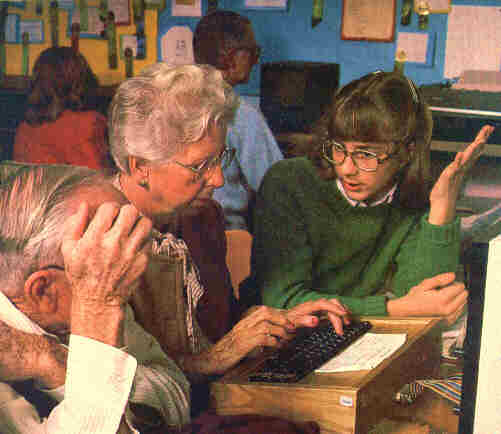Interactive Sciences has long used
"peer tutoring" to help people learn and teach about technology. Peer
tutoring is a fast, friendly, and easy way to learn almost anything.
A typical peer tutoring session using the computer has one student teach two
others. The tutor sits near the learners and never touches the keyboard.
Lesson plans help remind the tutor how and when to introduce new concepts and provide an
easy streamlined sequence.
 |
After six to ten hours of instruction (typically
one or two hours per week or over a weekend) and some additional practice, the learners
are themselves able to serve as tutors. With this "each one teach two"
approach, starting with just one student, you can generate hundreds of tutors within a few
months and thousands within a single year. |
What are the benefits of peer tutoring?
It's much easier to
learn when someone is right there to help you.
It's much more fun
to learn when a peer is helping you rather than a computer program or a busy teacher.
It's fun to teach others too.
Tutoring others
reinforces what you've just learned. There's an old saying that in order to know
something, you first have to teach it.
Studies show that
the total time for learning and then tutoring is less than the time needed for
conventional learning.
Peer tutoring means
learning is more social.
Learning from
others and then helping others learn shows how a whole community of education can be
built.
Many learners enjoy
being the "expert" for once, rather than always being taught to.
Peer tutoring
curriculum is much simpler than expensive computer-based education, so new subjects can be
introduced quickly into schools and communities.
Since just one
tutor can lead to thousands, teachers can use student expertise to help them introduce new
subjects.
How has Interactive Sciences used it?
Here are some examples:
At Ronald McNair
Middle School in the East Palo Alto School District in 1994, a core group of students
attended a weekend workshop to learn about the Internet and how to explain it to
others. They then held an intensive Internet training day to teach hundreds of their
schoolmates to use e-mail, the Web, visit news groups, and more. This project was
sponsored by NASA.
In San Jose, over
eight hundred educators attended the San Jose Education Network Summer Institute in
1994. Students from a number of San Jose schools taught Internet skills to the
teachers, a role-reversal that peer tutoring often makes possible.
In Jordan Middle School in the Palo Alto School
District, peer tutoring was used to teach over a thousand students to program in Basic and
to use a sophisticated word processing program. As a September
1983 Psychology Today article about our project indicated, we found that:
"children who have never written a legible sentence in their
lives are soon composing letter-perfect paragraphs and experiencing levels of
communication they feared would be denied them forever. That kind of rapid success
makes an enormous difference in how people feel about themselves, and about
learning."
At the Stanford Institute for Microcomputers in
Education, over 360 educators were taught word processing, spreadsheet use, and
programming by junior and senior high school students. The educators then taught
each other these skills, using a type of peer tutoring we call
"cross-tutoring". PC Magazine (October 1982) visited the Institute and
wrote that:
"Peer tutoring, a concept older than the one-room
schoolhouse, is an idea whose time has come again. ISI has updated it with its Computer
Tutor method, a system that promotes a chain reaction of learning."
Who else has used peer tutoring?
Peer tutoring is being used to teach in thousands of other situations. Here are
two interesting discussions of peer tutoring, one about a project to teach literacy
throughout an entire nation, the other detailing how peer tutoring can be more
cost-effective than alternative methods in U.S. schools:
Children of the Revolution: A Yankee
Teacher in the Cuban Schools
Kozol, Jonathan
Delacorte Press, 1978.
Cost-effectiveness of four educational
interventions.
Levin, H., Glass, V., & Meister, G.
Stanford, CA: Institute for Research on Educational Finance and
Governance, School of Education, Stanford University, 2-42, 1984.
